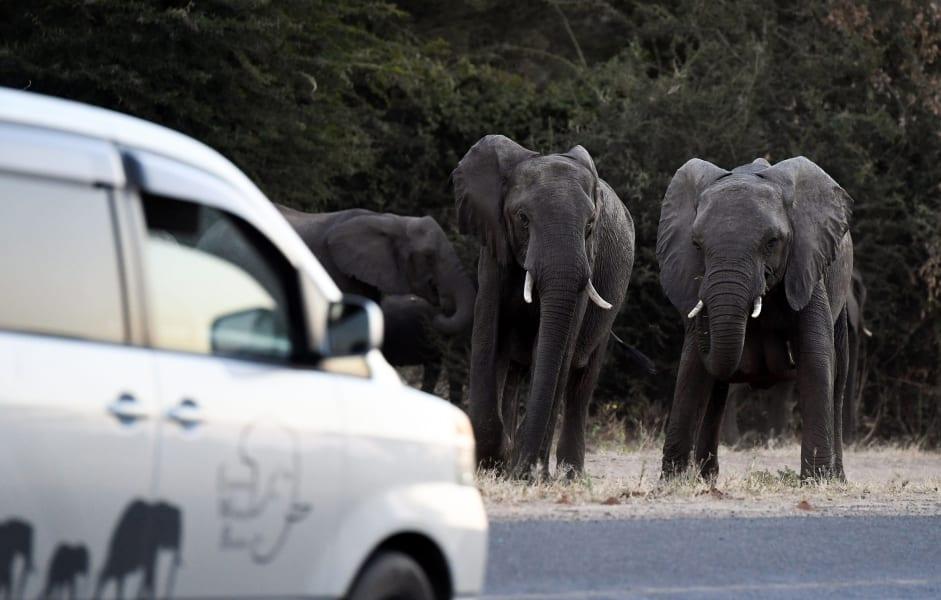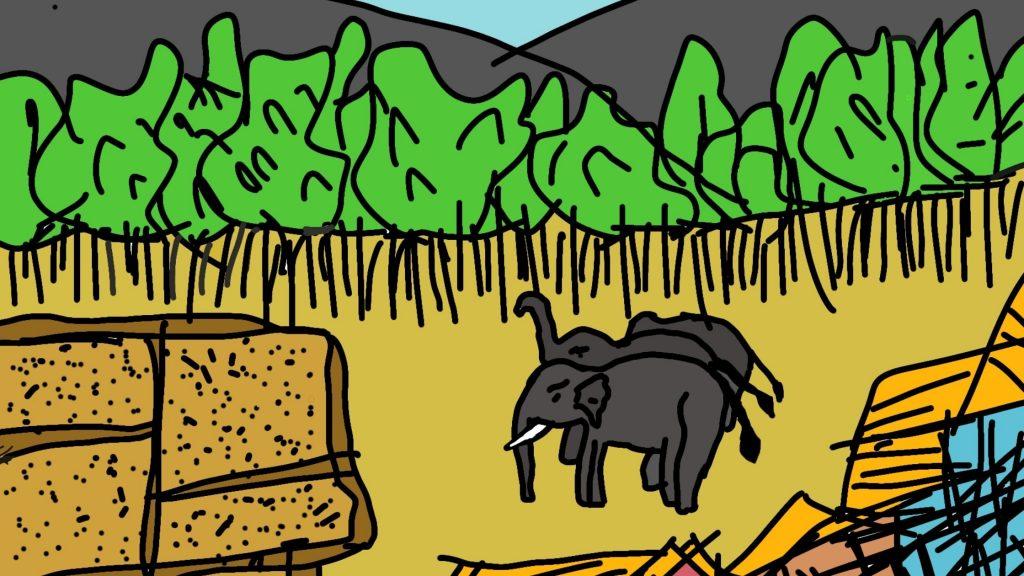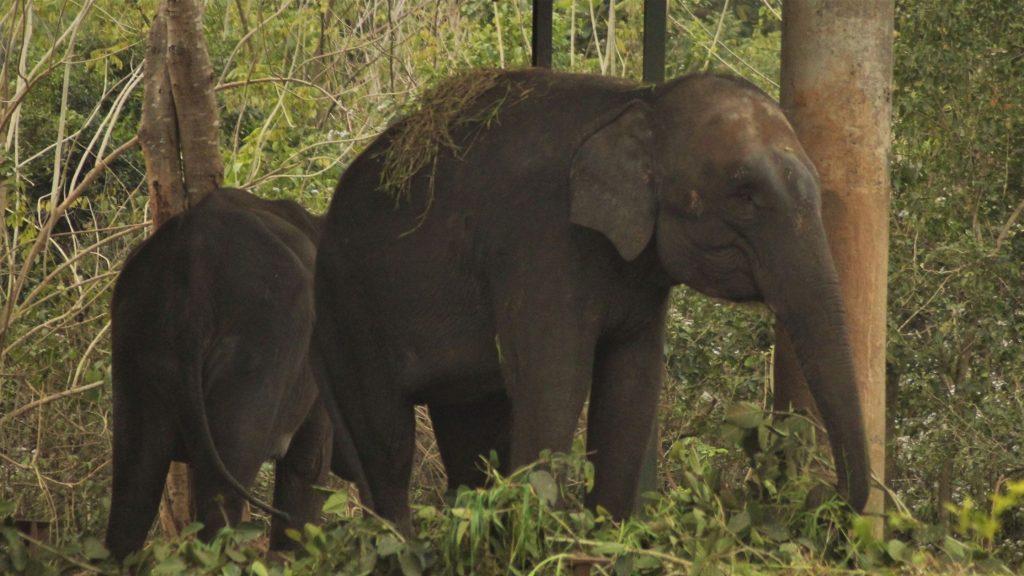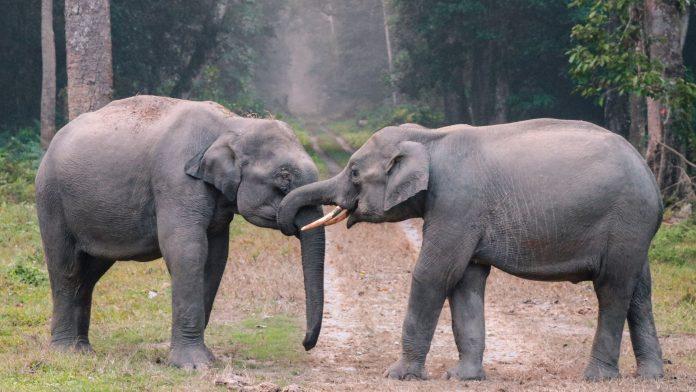Asian elephants are the keystone species that define the forest ecosystem in the Indian subcontinent. Rising human population and amoral anthropogenic pressures on the forest habitats have been diverting the movements of pachyderms towards human settlements in search of food and during migration. This has been causing a serious issue of conflict between humans and elephants in India and South Asia today. Annually, about 500 humans are killed in encounters with elephants, and crops and properties worth millions of rupees are damaged. That is equivalent to 0.8 to 1 million hectares of crops every year. Not only humans are affected by the conflict, after all, lots of elephants are killed successively (about 1500 in the last 15 years) due to human greed and indifference. Train hits, poaching for ivory, poisoning, and electrocutions are enormous obstacles to the elephants’ normal life cycle.
Studying the range of Asiatic Elephants brings forth the tragedy they are facing today. A vastly extended kingdom of elephants now stands isolated into broken fragments like a few drops of color splashed accidentally on a worn-out South Asian fabric. More than hundreds of fragments are scattered across this fragmented range. According to the 2017 elephant census of India, the country has a total of 27312 wild elephants, which is 55% of the wild elephants present in the Asian continent.
The elephant range is spread over about 65814 sq km of forest covers including 29 elephant reserves, 14 states, and 10 landscapes in the country. The long-term survival of a large-bodied, far-ranging animal such as the elephant can be ensured only through landscape-level maintaining of their viable populations along with suitable habitats. How large these landscapes should be is open to discussion. But it is clear from studies of the elephant’s home range, population dynamics, and elephant-human conflicts that this should be of the order of several hundred square kilometers. At a minimum in the short term, and certainly, several thousands of square kilometers to ensure the long-term viability of the elephant populations and reduced conflicts.
Fortunately, India does have a few areas where the above conditions are still met. The problem is that even here the options of keeping these landscapes without disintegrating further are fast disappearing. As the country moves into the high gear of economic growth, the symbols of development – roads, railway lines, dams and canals, pipelines, mines, expansion of settlement, and cultivation threaten to permanently rip apart the tattered habitat fabric. In many places, the linkages (or corridors) among elephant ranges hang by a thread.
Also read: Importance of Environment to Human Life
The elephant corridor is the connecting linkage through which the elephant can move freely and maintain its gene flow between two or more habitats. Of the 88 elephant corridors identified in 2005 by Wildlife Trust of India (WTI) and Ministry of Environment, Forest and Climate Change (MoEF&CC), 12 are in northwestern, 20 in central, 14 in northern West Bengal, 22 in northeastern and 20 in the southern part of India. But according to the WTI report published in the year 2017, the elephant corridor number has increased to 101 and seven of the previously declared corridors were excluded due to the immobility of elephants in those routes from the last decade. In India, only 24 percent of the corridor area is covered by complete forest patches. On the regional basis, 65 percent of the corridor are under forest cover in southern India, whereas 90 percent of the corridors are jointly under forest cover, agriculture, and settlements in central India and only 10 percent are covered by forest patch in that central region. About 28.5 per cents of corridors in India are found to be one kilometer or less in length, whereas, in southern India, it is 65 percent.
Fragmentation of elephant habitat is extreme in northern West Bengal followed by northwestern India, northeastern India, and central India respectively. As per the WTI report published in 2005 and 2017, the number of elephant corridors was found to have increased due to the fragmentation of surviving corridors. The fragmentation of corridors is mainly due to changes in land use such as roads, railway tracks, mining, conversion of forest land into agricultural lands, and human settlements.

The protection of the heritage animal of India with mitigation of Human-Elephant Conflict is the major topic nowadays. Weak regulation of ecotourism, mushroom farms, agricultural fields in the corridors, human settlements, etc., block the path of the elephant and degrade the habitat, resulting in human-elephant conflicts. As a result of the growing human population, the demand for land use, dependency on forests for fuelwood, timber, grazing of livestock, monoculture plantation like tea, eucalyptus, degrade the habitats.
Additionally, the entry of invasive species like Lantana and Parthenium becomes dominant over other local species reducing the foraging ability of elephants in a given area. As elephants are forced to range farther and farther afield, they enter into conflict with humans. As humans encroach on forest areas, planting nutritious crops near forest lands, they attract elephants. It has been seen that 40 percent of elephant reserves are vulnerable and not coming under the protected areas. Elephant corridors too face legal protection issues throughout their range.
One has to understand that protecting elephant habitats and corridors would be the solution to overcome the Human-Elephant Conflict issues in most places. Despite the role of elephants as “ Weak regulation of ecotourism ” and giving the strictest level of protection under the law, the elephant reserves, as well as linking corridors, should be protected legally under specific rules and regulations. In the recent past, the verification of elephant corridors has been carried out by mapping using GIS technology, which made it too easy to find out corridors throughout the country. Now the MoEF&CC has decided to conduct the first scientific estimation of elephants along with tigers and leopards in 2022. This will ensure the individual identification, monitoring, age detection, and nutritional status of the elephants.
Corridor securement: success stories
Of the 101 corridors identified, six have been secured and six more are currently in the process of being secured through an amalgam of the four models.
| S.N. | Secured corridors | Corridors in the process of being secured |
| 1 | Thirunelli – Kudrakote, Kerala | Kalapahar – Daigrung, Karbi Anglong, Assam |
| 2 | Edayarhalli – Doddasampige, Karnataka | Chamrajnagar – Talamalai, Mudahalli, Karnataka |
| 3 | Kaniyanpura – Moyar corridor, Karnataka | Kaziranga – Karbi Anglong, Panbari, Assam |
| 4 | Siju – Rewak, Meghalaya | Kaziranga – Karbi Anglong, Kanchanjuri, Assam |
| 5 | Rewak – Emangre, Meghalaya | Kaziranga – Karbi Anglong, Amguri, Assam |
| 6 | Chilla – Motichur, Uttarakhand | Kaziranga – Karbi Anglong, Deosur, Assam |
The Need to Upscale

Elephant corridors are now becoming a national policy initiative in India. Out of all corridors across the country having been documented, six of these have already having been secured. This may be a good beginning in the era of rising tide of Human-Elephant Conflict and no time is to be lost to expand this strategy. To secure all the 101 elephant corridors, the effort of local populations alongside the government and corporate sectors has to be synchronized and upgraded in the centralized vision of conserving elephants.
The strategic direction for this include
- In central and east India, 90 percent of corridors are passing the human settlement and agricultural field, it can be rewilded by formulating the plan of Nature Recovery Scheme as done by the English Government in England. In this scheme, the farmers are paid to rewild their land. In India, through formulating this scheme the corridor path would be enriched with native plant and grass species to avoid elephant and human conflicts.
- Most of the human deaths are caused due to disturbing by humans during the movement of elephants in the vicinity of villages or agricultural field, when the elephant aggressively resort to and cause destructions. During such conflicts, villagers should cooperate with forest officials instead of crowding to drive away the elephants and follow the prescribed protocols.
- For the protection of the existing corridors, the railway tracks and national highways that are cross the routes should have underpass or overpasses constructed according to the land type, so that the elephants can easily move in spite of the existing traffic. The underpass or overpasses should be of natural look and designed as suitable for the elephants as well as other wild animals. Speed limits of vehicles should be strictly enforced in the corridors.
- The corridor paths should be enriched with native plants of trees, shrubs, and herbs as well as water facilities in the water bodies during the dry period used by elephants where the fragmentation of the corridors has happened.
- From much research, it is found that 28 types of minerals are essential to elephants. When the elephants are unable to find nutritious food in the existing habitat, they start moving to another patch in search of good food. So basically, the movement of the elephants is according to the quality of food and availability of water in the area they inhabit. The elephant reserve and corridors should ensure the availability of rich and nutritious food suitable to elephants. The elephants can then obtain their food from the natural habitat. The habitat status in the elephant-rich areas have to monitored and regenerated by the forest department. This can minimize or eradicate the movement of elephants to a nearby agricultural fields.
- It is studied that elephants have found a quick response to change in forage type and availability of water. Mostly the elephants occupy lower elevations in the vegetation regeneration period but tend to move to higher altitudes evergreen forest after sensing the availability of vegetation. The human encroachment and agriculture fields nearby elephant habitats are mainly used by the elephants in the dry season and during the harvesting seasons.
- The mining areas should be specially planned to save the elephant habitat as well as the corridors. The forest patches are majorly affected in these areas. The elephant movement patches should be protected and regenerated with suitable plant species for the free movement of the elephants from one habitat to other. The active mining areas should be enclosed with solar fencing boundaries to avoid the demise of elephants.
Modern gadgets to prevent Human-Elephant conflict

- Use of IT technology: With rapid advances being made in the IT sector, programs can be made to detect elephant movements and warn the people well in advance using Apps that monitor the location of elephants especially on busy highways and railway tracks to help prevent collisions with vehicles.
- Use of Drones: Drones can be used to monitor the movement of elephant herds and warnings issues so people can move out of their way. Similarly, drones can be used to monitor the movement of elephants near the railway tracks so that the drivers are warned well in advance to slow down their trains.
- Railways: Drivers need to be trained on use of modern gadget and information systems to detect and take corrective actions to prevent collision with elephants in the elephant corridors.
- Underground cables: It is often seen that the elephants die due to electrocution by high voltage electric wires in the areas inhabited them when trees and other structures get exposed to naked wires. Wherever possible, cables should be connected underground so that the elephants can be saved.
- Wireless systems: The early warning system such as wireless tripwire system for undulating terrain as well as flat terrain have been succeeded to mitigate human-elephant conflict in Tamil Nadu.
- SMS: To alert people about the presence of elephants in the nearby area in advance after early detection, SMS or WhatsApp messaging system are helpful to prevent conflict and encounter with the elephants.
- Solar fencing: Solar fencings are used generally in the village boundaries as well as on agricultural lands close to elephant habitats. So that after contact of elephants to this fencing a mild electric shock to the elephant will avoid its entry into the village or agricultural fields. Then they find alternate migratory routes.
- Beehive fencing: Elephants instinctively avoid beehives and thus having beehives would benefit both the farmers as well as ecosystems other than acting as a deterrent to elephants to move into areas where they may cause damage.
- Solid barriers: Different types of natural and artificial barriers are constructed to guide elephants back into the natural habitat and also to minimize the conflict. Concrete barriers, barricading, additional walkways, elephant proof trenches, hanging fences, rubble walls near the human habitation, Trip alarm, sensory-based alarm, chili smoke, bio-fence like alternate cropping of citrus, chilies, ginger etc., which are not liked by elephants around the main crop can be very helpful in minimizing the conflict and movement of elephants through human habitations.
- Studies: Study of animal behavior and management planning accordingly. Very little has been done to study the animal behavior in the wild, understand their seasonal movements and this would become important to study for any strategy and long-term plan to be effective.
- Radio collaring: Radio collaring of elephants is most helpful in monitoring the movement of the elephants and understanding their ecological significance.
- Regeneration of native vegetation: Shrubs, trees and other suitable species for elephant and water facilities should be planted and maintained in the dry season in their habitat and corridors. Elephants do have the ability to dig soft soils and create water pools. However, this possibility will be useful when enough vegetation cover is provided for recharge of groundwater and increasing the water table.
- Artificial seeding: Artificial seeding of suitable grasses and herbs/shrub varieties in the corridors that pass by agriculture areas may be carried out so that there is enough green vegetation regenerated for consumption by the elephants as they move from one area to another, preventing the elephants from wandering into the agriculture fields.
- Fencing: Fencing to guide elephants near railway tracks and highways to pass through an underpass or upper pass where possible so that natural crossing points are used without a need for over construction along the railway tracts.
- Infrasonic sounds: All adult elephants can make infrasonic calls and make contact with each other. Some researchers also assume that the elephants use infrasound of thunderstorms to find water resources during dry periods. So subsonic frequency systems of low frequency (below 20 Hz) along train lines can be used to mitigate the demise of elephants in railway tracks. That gets activated when a train is within 2 kilometers, so elephants are dissuaded from crossing the railway lines. Elephants avoid bees, so the bee sound can be played in this context, which has been found to be helpful in keeping elephants in Northeast India.
Read more:
- Mangroves – Nature’s shield against natural disasters and climate change
- Vanishing Grasslands: The basis of Rural Livelihoods and Sustainability
- Effects of Global Warming and Climate Change
- The Connection Between Environment and Human Health
About author:
Mr. Ravi Shankar Behera is an independent freelance consultant and author based in Hyderabad. He is an Honorary Advisor to grassroots Voluntary Organizations on Food Security, Environment, and Social Development issues. Ravi has worked with international donors and NGOs over the last two decades and has a keen interest in Agriculture, Food and Nutrition, Environment, Natural Resource Management, and Climate Change issues.
Mr. Neelamadhab Sahu is working with Wildlife Institute of India as a researcher. His interest includes research on flora and fauna, writing science story for school children, and communicating science with the community. He is a nature and wildlife photographer by passion.
Dr. Ranjit K. Sahu is an American laboratory and research specialist located in Virginia, USA. Dr. Ranjit is a freelance writer, artist, poet, and story writer. He has over 18 years of experience in Biotechnology and biomedical research. His interests include education, environment, sustainability, and health care systems and practices in the underprivileged regions of the world.


